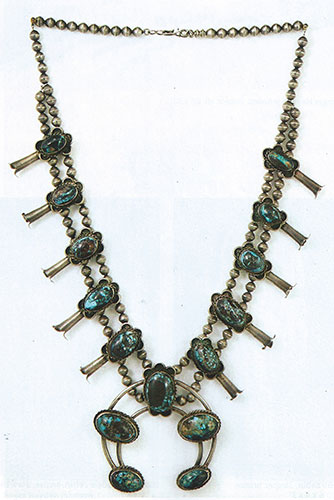Vintage Turquoise Squash Blossom Necklaces
By Medicine Man Gallery on

Antique Turquoise Squash Blossom Necklaces: A Resurgence of Style
Medicine Man Gallery offers you the finest selection of authentic antique, vintage turquoise squash blossom necklaces for sale from the Navajo, Zuni and Hopi Native American cultures.
by Dr. Mark Sublette
Published online courtesy of Western Art Collector, July, 2013
The old adage is wait a while and your parent’s fashion style will come back. This has never been more true than for Native American squash blossom necklaces which will be featured at Medicine Man Gallery Santa Fe for the month of June.
The distinctive feature of the necklace is the crescent-shaped pendant, the naja (NAH-zha) that has its origins from Europe and the Mediterranean.

Navajo Bisbee turquoise and silver squash blossom necklace, ca. 1950, 29" long, naja is 3.5"x3.5"
Both the Spanish and the Plains Indians used the naja to decorate the forehead of horses in the 19th century. The Navajo started making silver-mounted bridles in the 1880s and the naja was soon transformed into decoration for necklaces made from coin silver. The term "squash blossom" comes from the squash flower often associated with native cultures, though the unique naja design most likely came from pomegranate tree flowers, which originated in Europe.
Simple silver squash necklaces were first made by the Navajo, but not long after the Zuni started making pieces and to a lesser extent the Hopi. The Zuni silversmiths focused on small clusters of turquoise and coral, often daintier in appearance. The Navajo also used turquoise but usually in nuggets or cabochons. There are a large variety of Navajo squash blossom necklaces, and many of these pieces were made in the late 1960s.

While squash blossoms may have been worn in the southwest since the 1890s, their hey day was the late 1960s and early 1970s. It was a time of free love, the Doors and of course great Squash blossom necklaces flowing over paisley shirts accented with platform shoes. Many Indian art dealers cut their teeth during this time building careers around the craze. Gilbert Ortega was the king of the squash blossom necklace; he would fly his plane around to his different shops in numerous states trying to keep up with orders. Prices skyrocketed, but like any bubble it popped in the early ‘70s as tastes changed and heels got shorter.
The good news for today’s collectors it the prices for many of the 1960s pieces are much less in today’s dollars than 50 years ago. The pre-1960s pieces are very collectable. In general price structure for a 1930s squash would be in the $2,000 to $3,000 range and can easily top $8000 for an turn of the century ingot piece. Many coin squash necklaces seen in today’s Indian shops were made in the 1960s, so if you see one with barber head quarters dating from the early 1900s these are usually revival pieces from the 1960s.

Navajo silver and turquoise squash blossom necklace, ca. 1920, 1.875"x2.875"
The Squash Blossom necklace collection on exhibit at Medicine Man Gallery will feature examples from 1900s to 1960s with the majority of pieces 1940 and before. The show runs June 1st to July 3rd at 602A Canyon Road, Santa Fe, New Mexico. For questions or to learn more visit our website www.medicinemangallery.com or contact us at 1-866-894-7451.
Images courtesy Mark Sublette Medicine Man Gallery, Tucson, AZ and Santa Fe, NM.